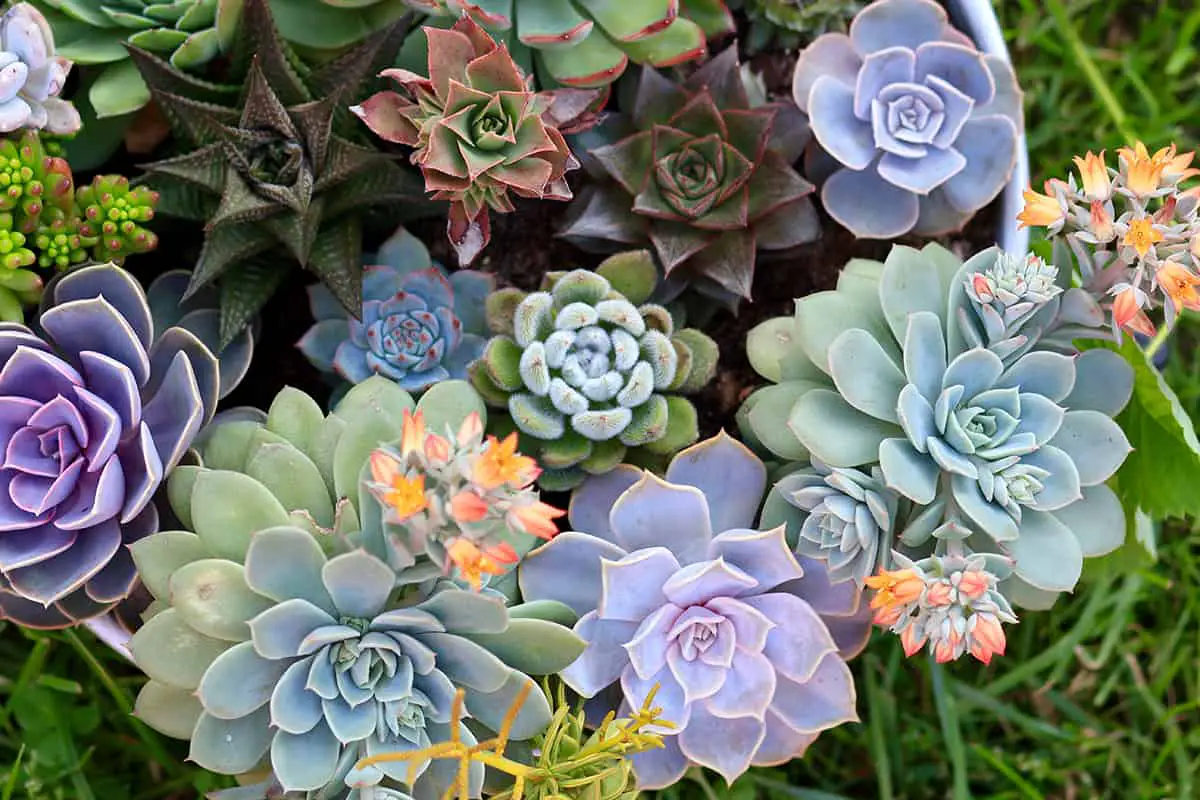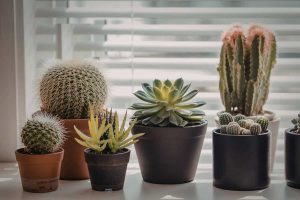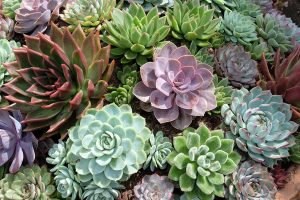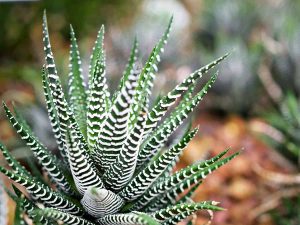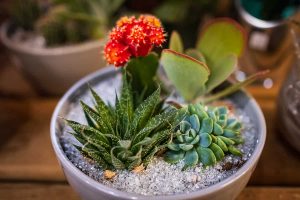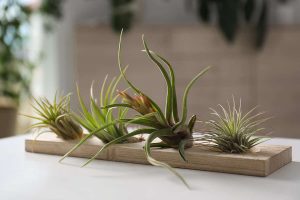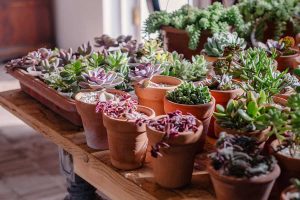As the morning sun peeks into a cozy kitchen nook, the vibrant pinks and yellows of indoor succulents greet it, their blooms a dazzling contrast against the desert-like greens and grays. Outside, in the rock garden, larger succulent varieties mirror this display, turning a sun-drenched patch into a tapestry of color.
Flowering succulents, both indoors and outdoors, offer a low-maintenance yet visually striking addition to any plant collection, and with the right care, they can turn a plain space into an exotic retreat.
Table of Contents
- Aloe Vera
- Echeveria
- Sempervivum (Hens And Chicks)
- Kalanchoe Blossfeldiana
- Jade Plant (Crassula Ovata)
- Schlumbergera (Christmas Cactus)
- Sedum (Stonecrop)
- Haworthia
- Gasteria
- Graptopetalum
- Senecio (String Of Pearls)
- Aeonium
- Portulaca (Moss Rose)
- Adenium (Desert Rose)
- Agave
- Pachyphytum
- Rhipsalis
- Gymnocalycium (Moon Cactus)
- Anacampseros
- Stapelia
- Crassula (Fairy Crassula)
- Lithops (Living Stones)
- Orostachys (Chinese Dunce Cap)
- Euphorbia Milii (Crown Of Thorns)
- Huernia
Aloe Vera
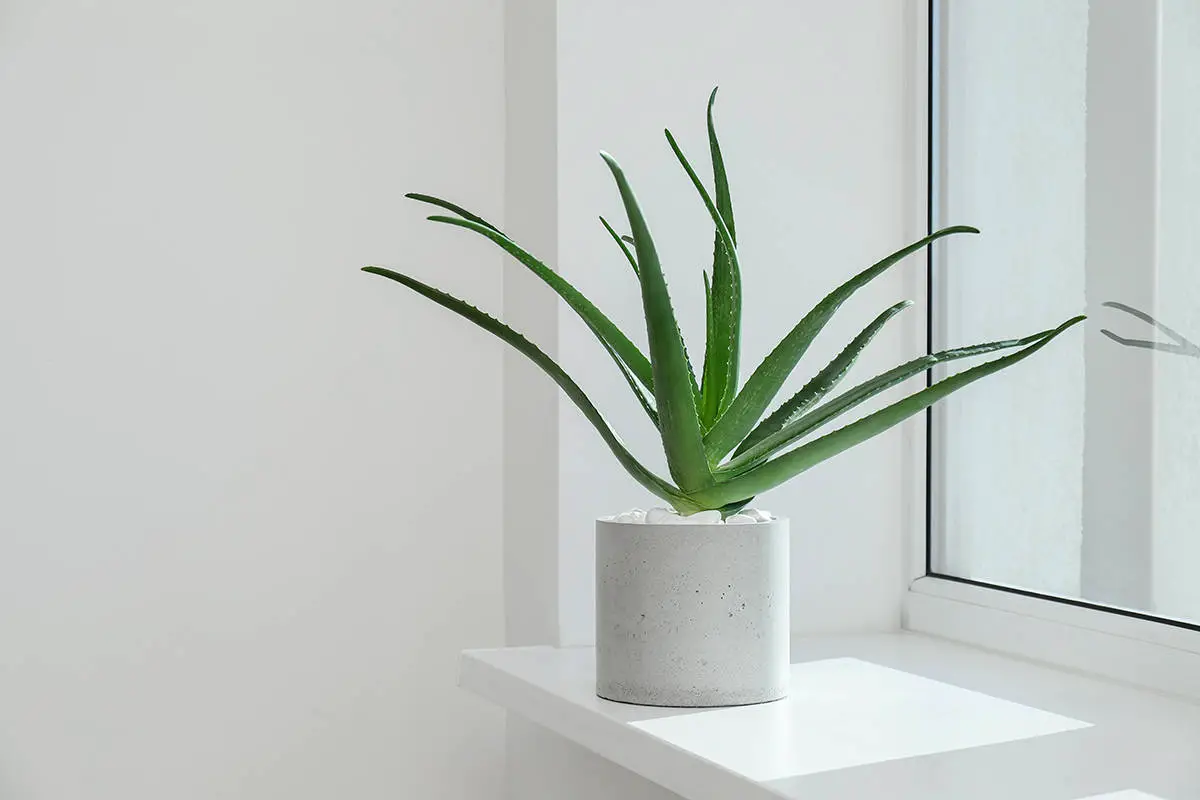
Aloe Vera grows as a succulent with thick, spiky leaves. Your indoor space remains bright with its presence. Place it near a window where it can receive sufficient indirect light. Sunlight helps Aloe Vera thrive but avoid harsh direct rays which may harm the leaves.
Outdoors, Aloe Vera can reach two feet in height. In climates not prone to frost, you can grow it outside year-round. If winters are cold, consider pots for easy transfer indoors. During late winter or spring, the plant may produce yellow or red flowers.
Aloe Vera prefers well-draining soil to prevent waterlogging. Overwatering is a common mistake, so water only when the soil feels dry. The plant’s watering needs are low, making it suitable for those with busy schedules.
The plant’s gel is valued for its soothing properties. You can use it topically for minor burns and skin care. Remember to harvest sparingly, allowing the plant to recover.
Echeveria
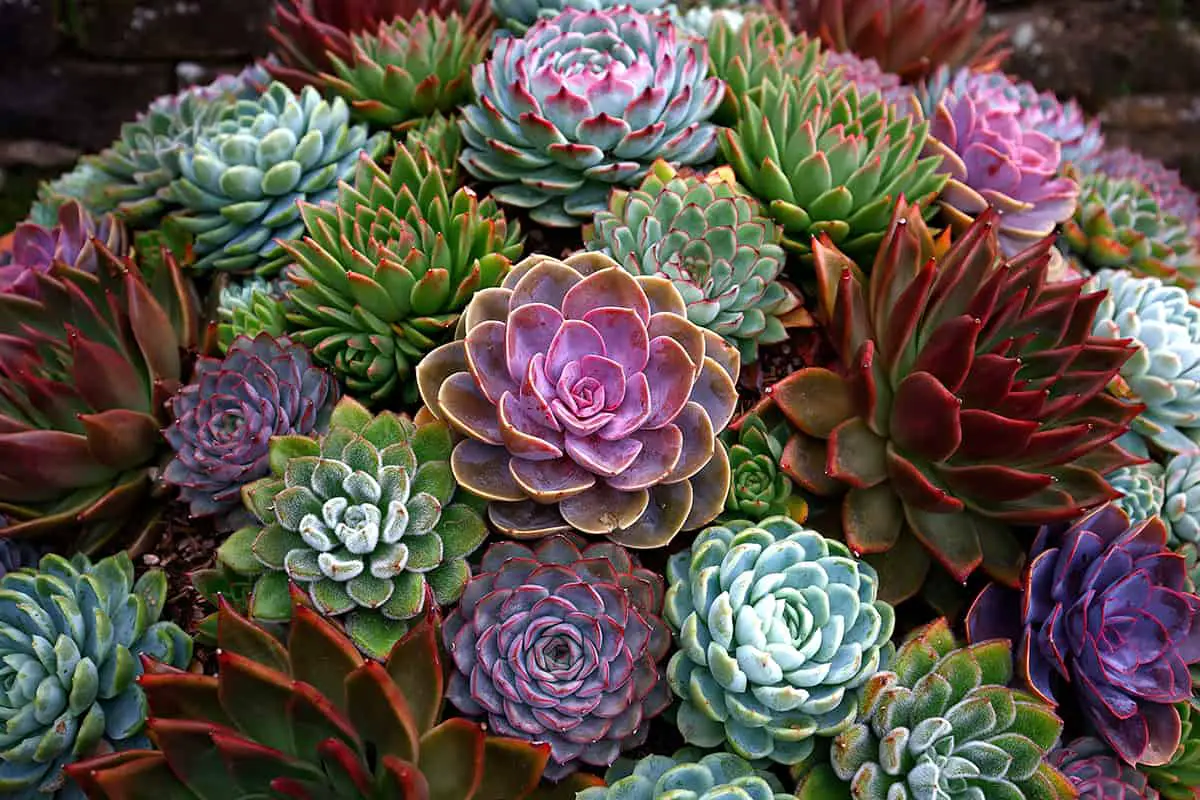
Echeveria succulents are a delightful addition to your plant collection. With their rosette shape, they offer lovely foliage often sought after by indoor and outdoor gardeners alike. You can grow Echeveria in containers, making them versatile for various settings.
Proper care is crucial for these plants. They thrive in sunny conditions and require minimal watering. In fact, too much water can harm them. Ensure the soil is well-draining and that you allow it to dry between waterings.
When cultivating Echeveria indoors, choose a bright spot. A window that gets sunlight is ideal. These succulents can also enhance outdoor spaces, but remember to protect them from excessive rainfall.
Propagation of Echeveria is straightforward. You can expand your collection by using leaf cuttings. In time, your Echeveria may even reward you with flower stalks, attracting bees and hummingbirds.
Sempervivum (Hens And Chicks)

Sempervivum, often called Hens and Chicks, thrives both indoors and outdoors. You will find its rosettes both attractive and diverse. The plant got its name due to its method of propagation. A central “hen” produces small “chicks” around it.
These succulents require good drainage and moderate water. Outdoor plants prefer full sun but will tolerate partial shade. Indoors, place them in bright, indirect light. They can endure colder temperatures, making them ideal for many climates.
Sempervivum displays a variety of colors and textures. Your garden or indoor pots will benefit from these eye-catching succulents. During summer, they may flower, adding to their charm. After flowering, a hen typically dies, but the chicks fill in space quickly.
You can easily separate chicks from the mother to propagate new plants. This plant suits rock gardens, containers, and ground cover. It is drought-tolerant, thus ideal for xeriscaping. Remember, overwatering is a common issue with succulents; ensure you let the soil dry between waterings.
Kalanchoe Blossfeldiana

This succulent plant, often referred to as the Florist Kalanchoe, showcases flowers in a variety of colors, making it a lively selection for your space.
If you select Kalanchoe Blossfeldiana, you provide a bright spot in well-drained soil. It’s key for you to let the soil dry between waterings. In optimal conditions, this plant can re-bloom, offering a renewable splash of color.
Indoors, Kalanchoe Blossfeldiana calls for a sunny window with ample light. While it’s durable enough to handle dry indoor air in winter, this plant favors normal room temperatures. When the risk of frost has passed, you can take it outdoors to a lightly shaded area for the summer months.
This succulent requires some care to maintain its compact shape and encourage flowering. Pruning tall growth and old flower stems will serve this purpose well.
Jade Plant (Crassula Ovata)
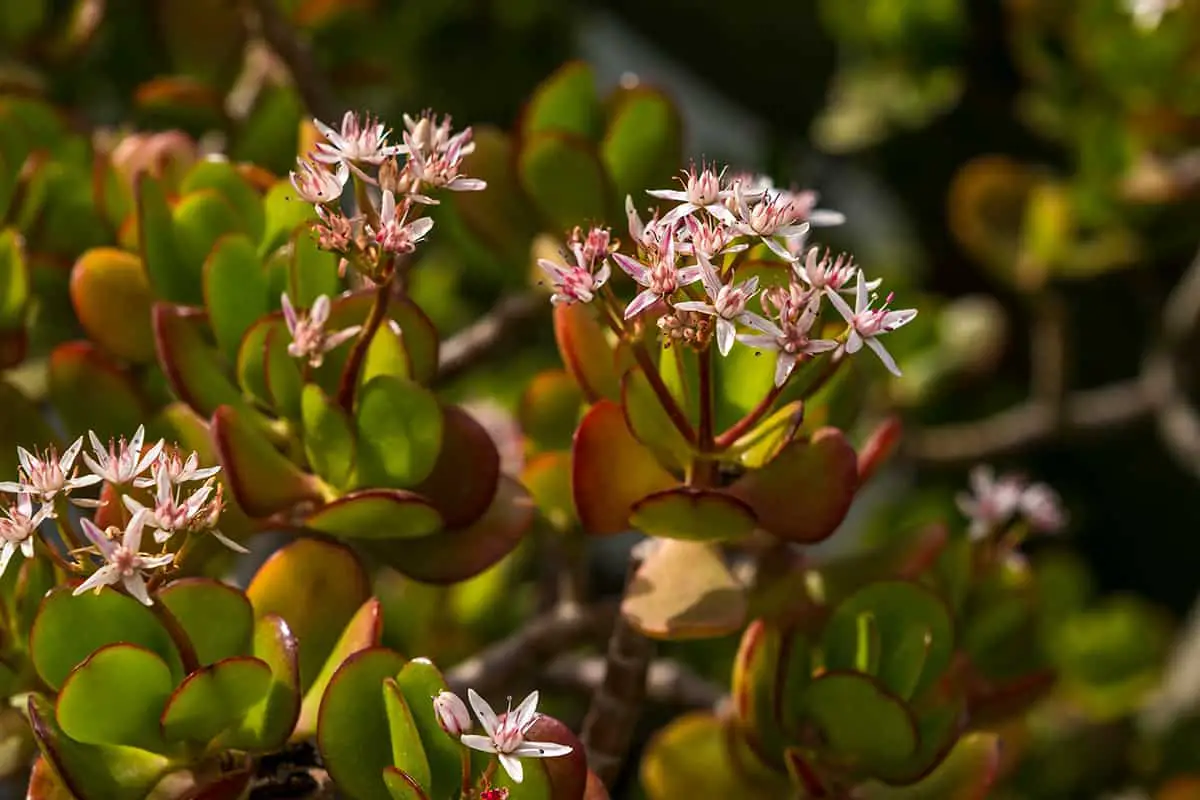
Jade plant, also known as Crassula ovata, thrives indoors and outdoors. You easily grow this flowering succulent in your home or garden. Its fleshy, oval leaves give it a unique, vibrant look. Crassula ovata prefers a mix of direct and indirect sunlight.
Proper watering is key for a healthy plant. Water your jade plant when the soil is dry to the touch. Overwatering leads to root rot. This plant stores water in its leaves, which lets it withstand dry periods well.
Jade plants often live for many years. With proper care, they grow into small, tree-like structures. They make a lasting addition to your plant collection. Crassula ovata blooms with small, star-shaped flowers.
This plant is also known as a symbol of good luck. People sometimes call it the “money plant.” It’s a popular gift to convey wishes for prosperity.
Schlumbergera (Christmas Cactus)
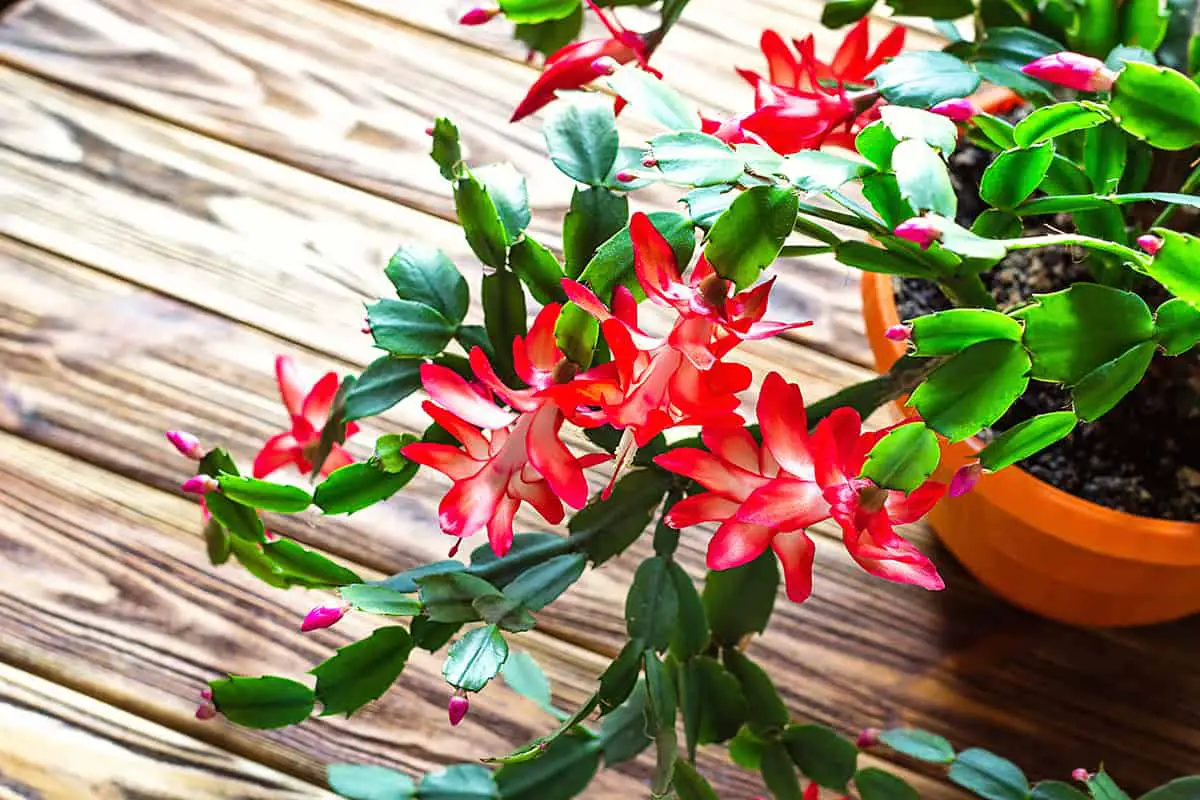
Schlumbergera, commonly known as Christmas Cactus, thrives indoors or outdoors in suitable climates. You can identify these succulents by their flat, segmented stems. Vivid blooms appear at the tips from November to February.
Indirect light suits Christmas Cactus best. Place yours near a window but away from direct sunlight. Allow the soil to dry slightly between waterings. Ensure the pot has drainage to prevent root rot.
Schlumbergera prefers a range of 60-70°F (15-21°C). Avoid places with drafts or heat sources.
Repot your plant every two to three years to refresh the soil. Use a well-draining potting mix designed for succulents or cacti.
Christmas Cactus is not a desert cactus. It is native to Brazilian rainforests, making its care different from other succulents.
Sedum (Stonecrop)
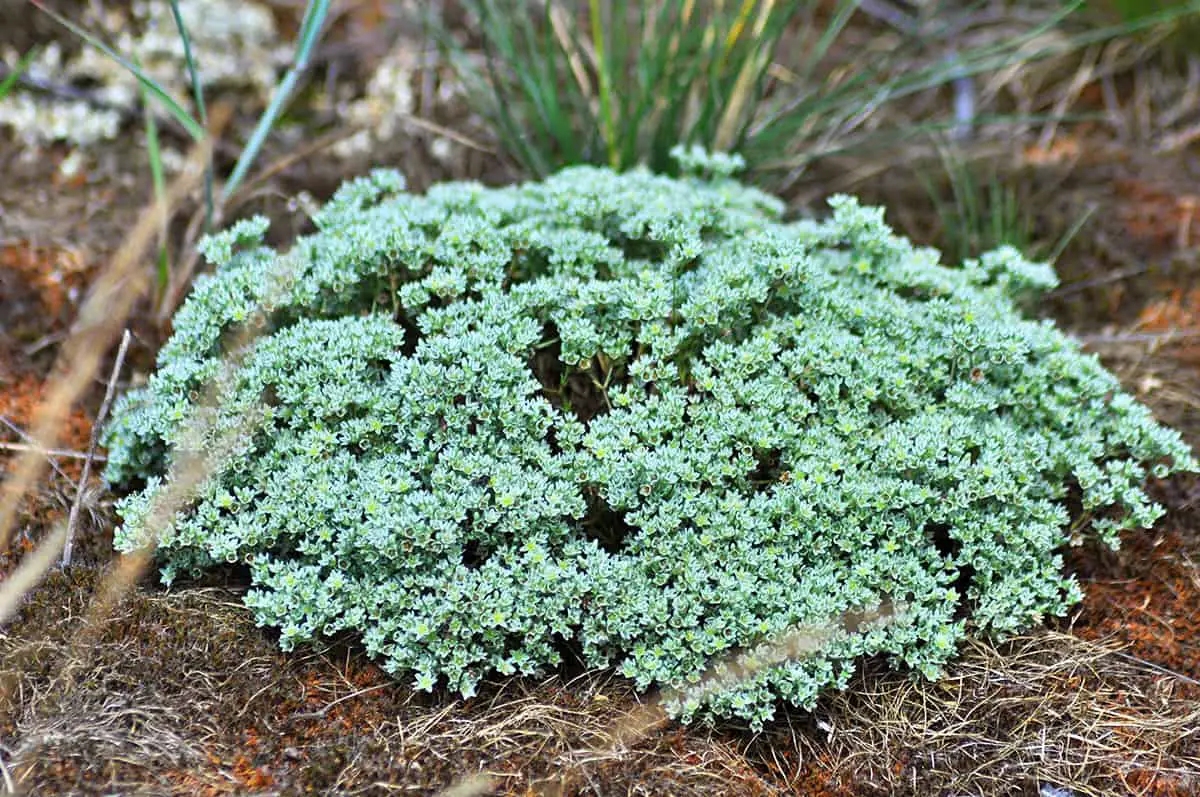
Sedum, known as Stonecrop, is a succulent you can grow indoors and outdoors. These plants have fleshy leaves and come in various colors and shapes. If you want to add Sedum to your collection, choose a spot with plenty of sunlight.
For indoor Stonecrops, ensure they receive bright, direct light. A south-facing window is ideal. Use a well-drained soil mix, such as a cactus blend, to promote healthy growth.
When planting outdoors, choose a location with full sun to part shade. Stonecrop thrives in well-drained soil. Water infrequently, as overwatering can harm these drought-resistant plants.
Varieties to Consider:
Matrona is a robust variety with pink flowers. Also consider Sedum morganianum, with cascading stems ideal for hanging baskets.
Haworthia
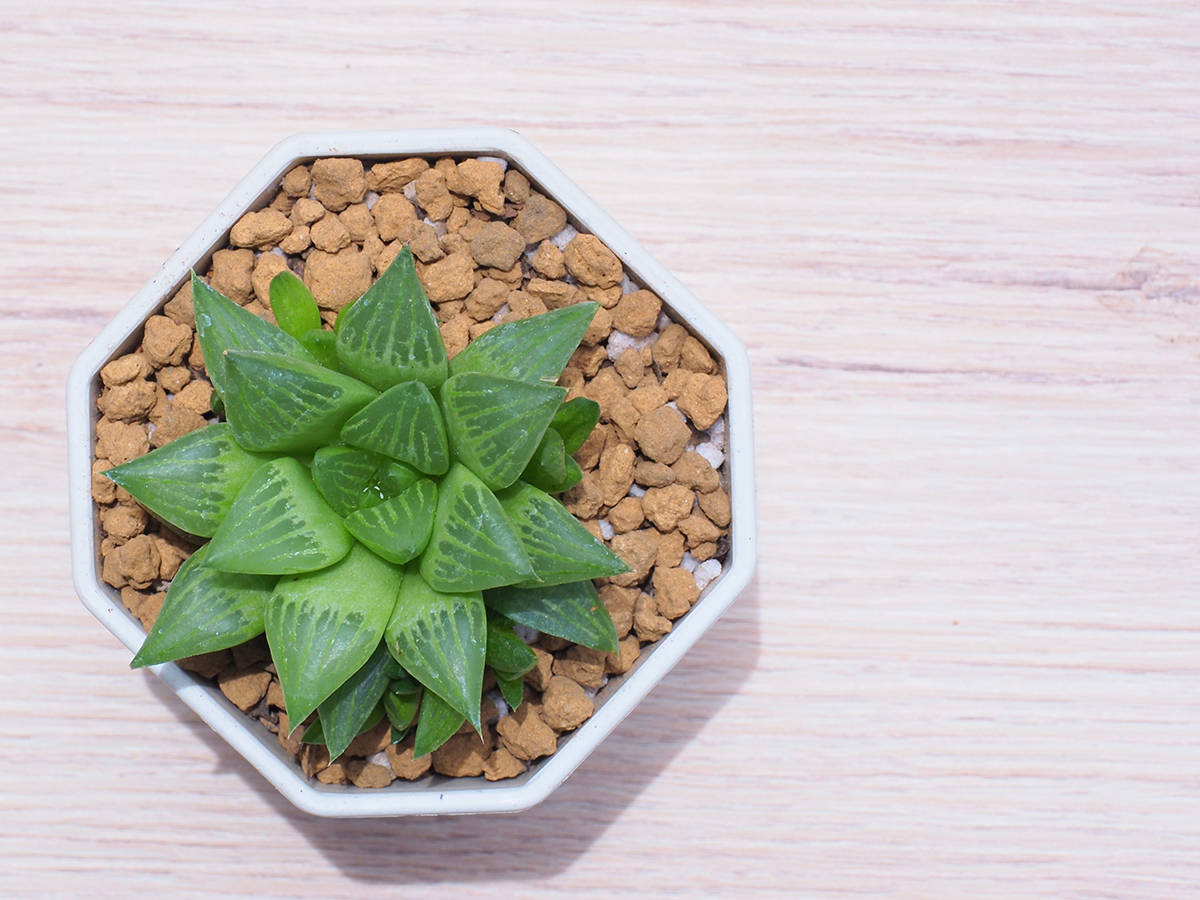
Haworthia is a genus of small, rosette-forming succulents. They originate from southern Africa. These plants are ideal for indoor and outdoor cultivation. They often have fleshy leaves with interesting patterns.
Unlike other succulents, it thrives in modest lighting conditions indoors. Place it in bright, indirect light. Ensure the soil drains well and water is infrequent.
In suitable climates, Haworthia can grow outside. They prefer shaded areas, avoiding direct, harsh sunlight. Shield them with shrubs or rocks. They handle mild frost but protect them in harsher winters.
Many beautiful variations exist within the genus. Their size is convenient for small spaces. Some species boast translucent leaf windows. These enhance their visual appeal.
When caring for Haworthia, monitor moisture levels. Do not overwater. Your Haworthia should not sit in waterlogged soil. Patient care yields a slow-growing, long-living succulent that enhances your space with minimal effort.
Gasteria
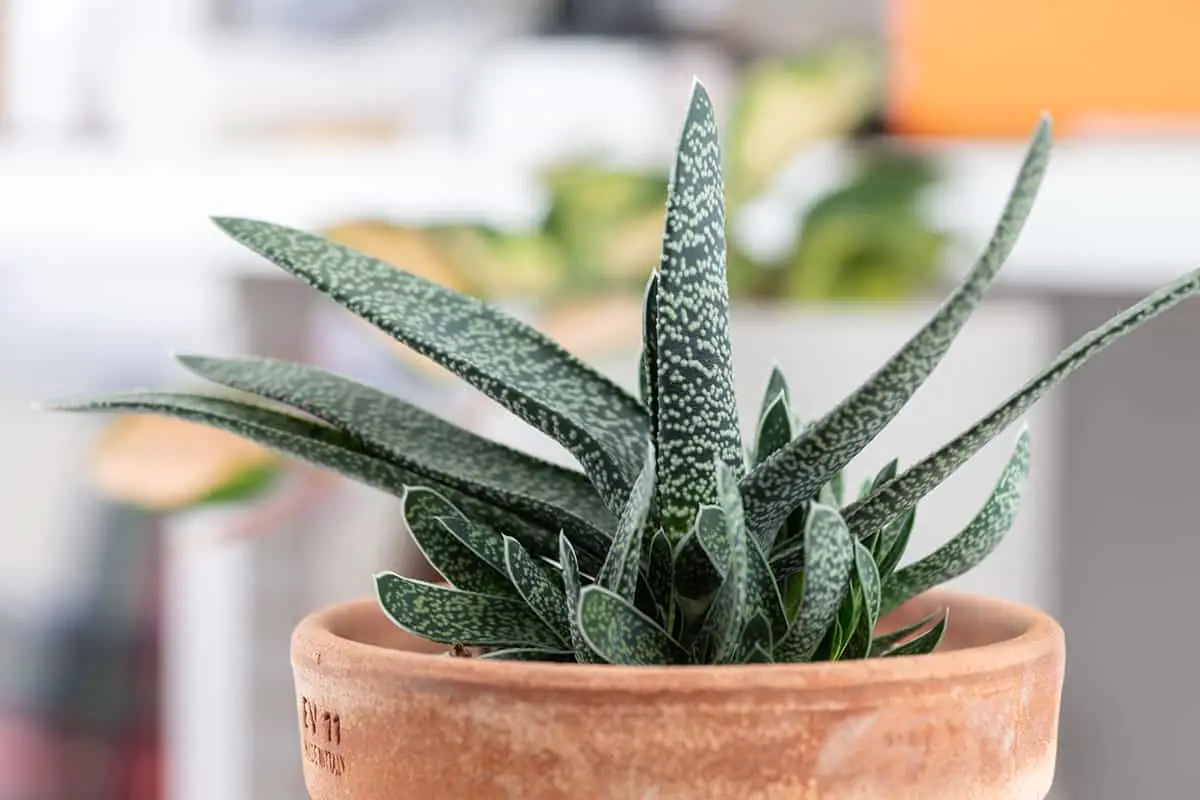
Gasteria plants, often called Ox Tongue, are unique succulents. Originally from South Africa, they adapt well to indoor and outdoor environments. Your Gasteria will grow as a small, sturdy plant with thick, fleshy leaves.
These leaves have a distinct appearance. Deep green to gray in color, they often feature white dots or warty outgrowths. This leaf pattern adds texture to your Gasteria plant.
Gasteria flowers are quite striking. They present themselves in winter to spring, adding a pop of color to your space. The flowers are small, tubular, and may display a vibrant, bi-colored pattern.
When choosing a spot for your plant, bright, indirect light is ideal. Whether indoors or out, Gasteria prefers well-draining soil. Paired with occasional watering, these conditions promote healthy growth.
In temperate climates, Gasteria thrives outdoors. It can tolerate light shade and requires minimal care. Protect your plant from extreme conditions to maintain its compact, robust form.
When you keep Gasteria indoors, a pot with drainage holes is essential. Mixing potting soil with sand improves drainage. Regular watering is key, but let the soil dry between watering sessions.
Graptopetalum
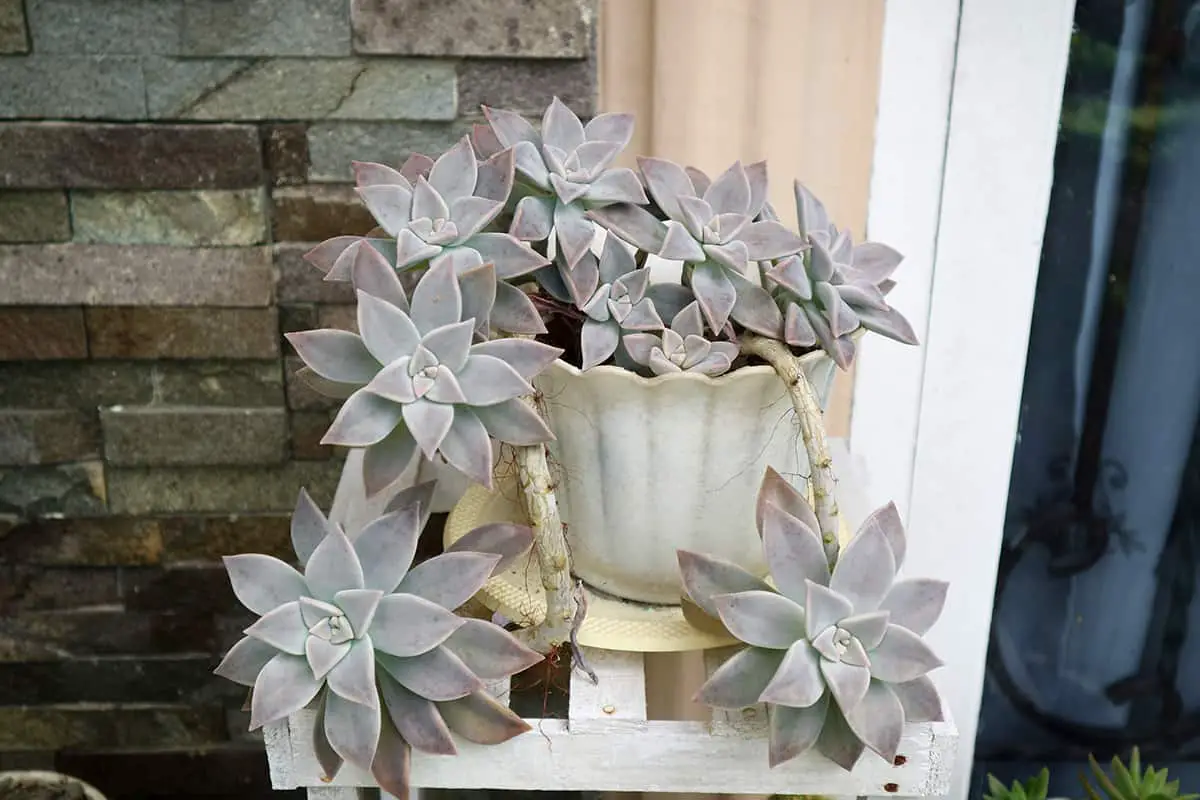
To grow your Graptopetalum successfully, provide it with well-drained soil and expose it to full sun to partial shade.
Outdoor plants can withstand temperatures down to 15 degrees Fahrenheit with some protection, an impressive feat for succulents. If you live in cooler climates, keep your Graptopetalum in containers so you can bring them inside when the weather turns cold. Remember, wet and freezing conditions are not suitable for these tough yet delicate beauties.
When caring for Graptopetalum indoors, select a bright spot where it receives plenty of indirect light. This plant will bring a unique aesthetic to your space with its rosette pattern and pale hue, often referred to as the ghost plant. The fleshy leaves may take on a beautiful blush when happily stressed through limited watering or cooler temperatures.
These versatile plants blend well in rock gardens or as ground covers and add texture to container gardens. Ensure that they stay dry during rainy seasons if they are outside, as excess moisture could be harmful. Rotate your Graptopetalum periodically to ensure even growth and to keep it looking its best regardless of where it’s planted.
Senecio (String Of Pearls)
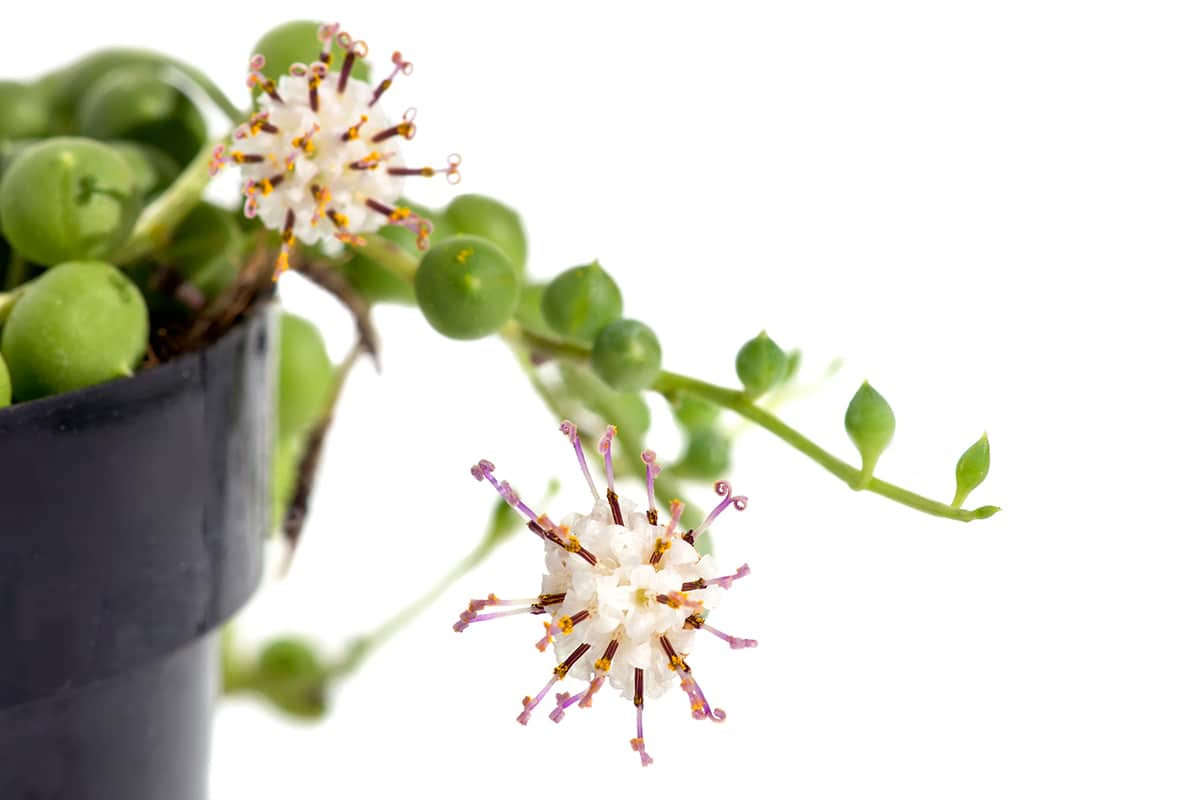
Senecio rowleyanus, commonly known as String of Pearls, offers a distinctive look for your indoor or outdoor garden. Its pea-shaped leaves dangle from strings, resembling a beaded necklace. This succulent thrives in bright, indirect light and well-draining soil. It’s native to South Africa, which means it prefers environments that mimic a dry, desert-like climate.
When you care for your String of Pearls, remember that like many succulents, it doesn’t need much water. Let the soil dry out completely between waterings to prevent root rot. For a happy plant, ensure temperatures stay above freezing. It’s known for being a bit delicate, so handle it gently to avoid leaf loss.
If you plan on keeping it outdoors, choose a spot with partial shade. Direct sun can scorch the foliage. Indoors, place it near a window but out of intense sunlight. Your String of Pearls might even reward you with small, white flowers. The blooms have a sweet, cinnamon-like scent.
Aeonium
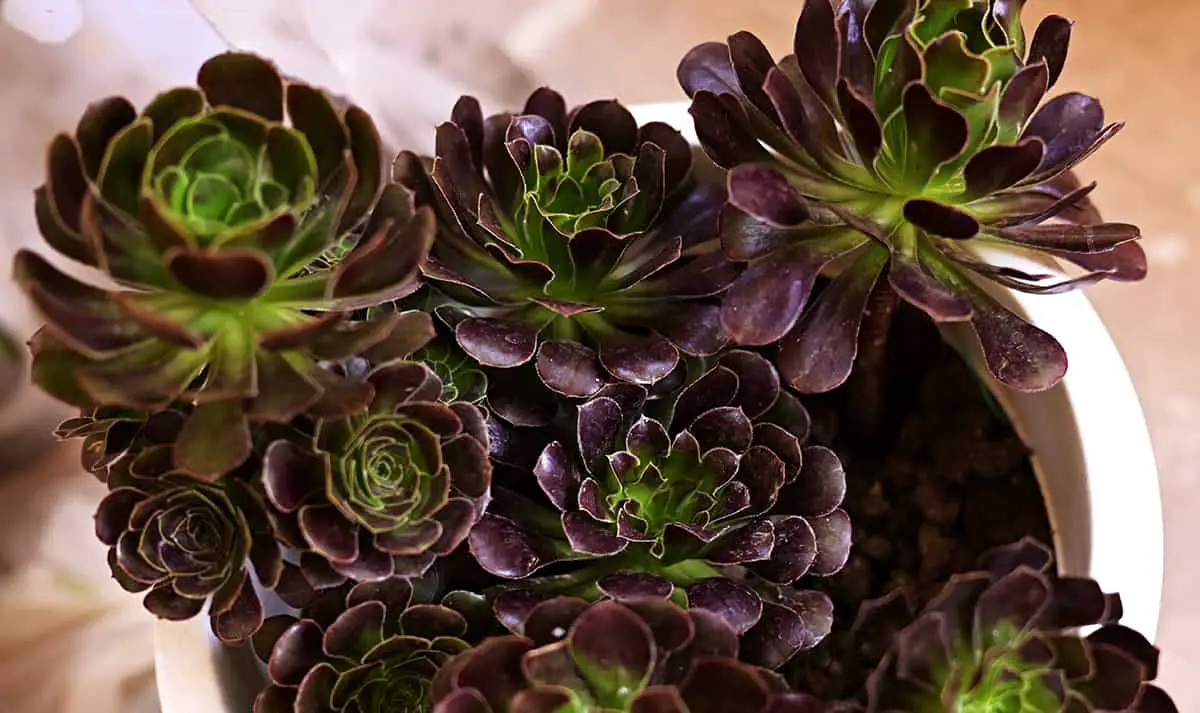
Aeoniums are versatile succulents that you can grow indoors and outdoors. These plants form beautiful rosettes and range in color from deep green to burgundy. When you choose an Aeonium, you’re selecting a succulent known for its ease of care and striking appearance.
When you grow these succulents inside, ensure they receive bright light. They are perfect for a sunny windowsill. During winter, Aeoniums enter a dormant state and require less water. You will find them easy to maintain as houseplants.
If you live in a warm, dry climate, you can grow Aeoniums outdoors. These plants do not survive cold winters, so if you’re in a cooler region, consider using containers. This allows you to bring them indoors when necessary.
Flowering is a unique event for Aeoniums, as the rosettes die after they bloom. Branching species can continue to grow, while others need propagation from seeds. Your Aeonium may be less common if it’s unbranched, since these varieties rely solely on seed growth.
Portulaca (Moss Rose)

You can recognize this plant by its colorful, cup-shaped flowers and fleshy leaves. Moss Rose prefers bright light when grown inside your home. Ensure the soil is well-draining to prevent root rot. Outdoors, it withstands hot, dry conditions well and can add vibrant color to your landscape.
Your indoor space can stay bright with Moss Rose’s varied hues. Each bloom lasts just a day, but don’t worry. New flowers will greet you daily during its growing season.
Adenium (Desert Rose)

You can identify Adenium by its thick, bulbous base and lush, trumpet-shaped flowers. Growing them in your home or garden adds a vibrant touch. They are native to arid regions and thus adapted to survive with minimal water.
For successful growth, provide your Desert Rose with bright light. They flourish in warm, dry climates, making them perfect for sunny spots. If you live in a cooler environment, consider growing them indoors. They will need protection from the cold.
When watering, do so sparingly. Over-watering is a common mistake that can harm the plant. This succulent prefers well-draining soil, similar to that of its native desert habitat. By allowing the soil to dry out between watering, you mimic this environment.
Agave
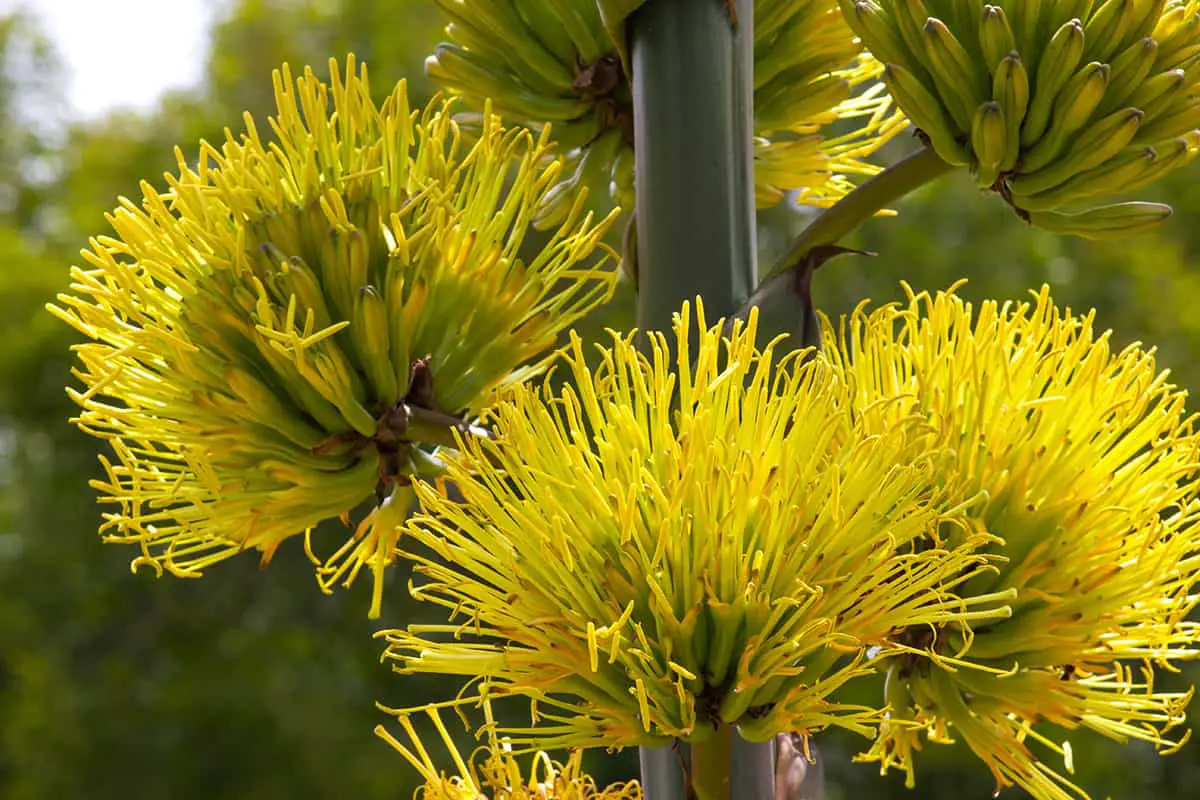
Agave plants bring a touch of the desert to your home. These succulents thrive both indoors and outdoors with ample light. If you live in a frost-free area, you can plant agave outside. As indoor plants, they require a bright, well-lit space.
Agave leaves are thick and fleshy. They form large rosettes that can be impressive in size. The leaves may have sharp edges. Handle them with care. They come in colors like green, blue, and silver.
These plants grow slowly. They flower once in their life, often after many years. When they bloom, a tall flower stalk rises from the rosette. It bears large, dramatic flowers.
To care for your agave, give it well-draining soil. Water it sparingly. Overwatering can harm the plant. Ensure it gets enough sunlight. For temperature, the ideal indoor temperature is 60-85°F (16-29°C), and it is frost-free outdoors.
Pachyphytum
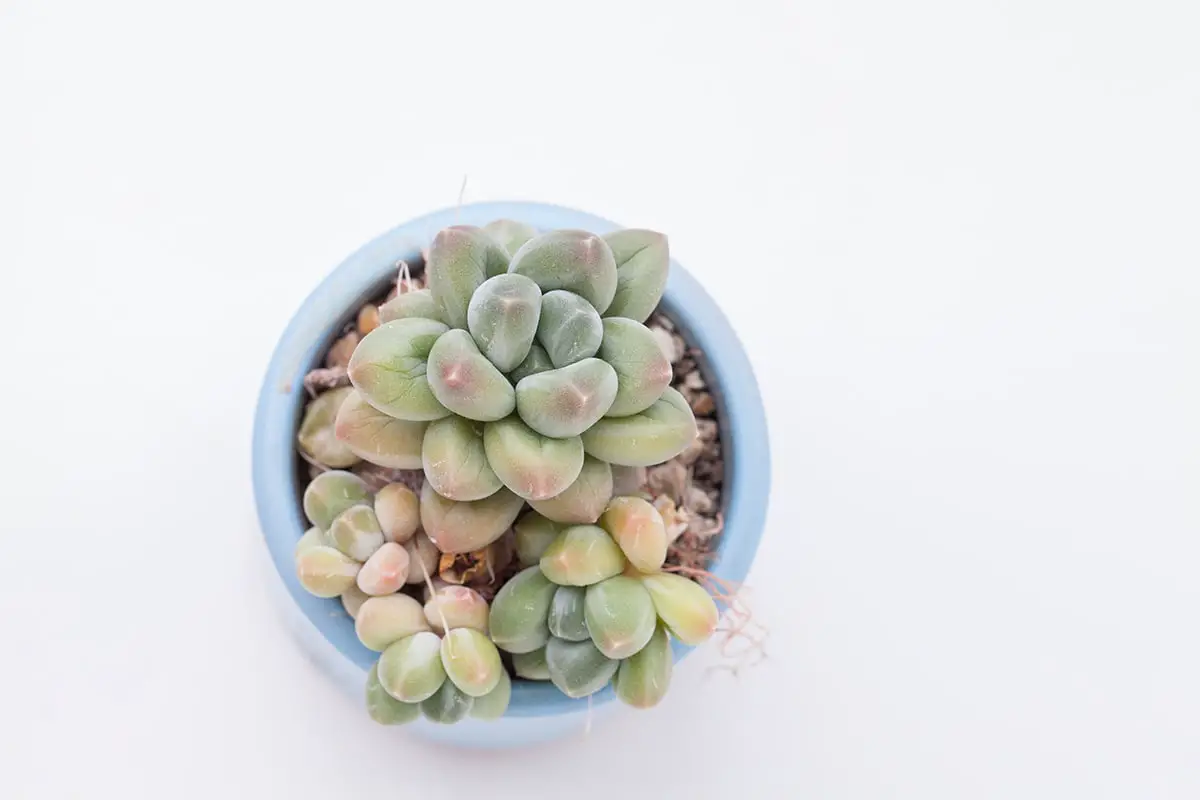
Pachyphytum is a type of succulent that you can grow both indoors and outdoors. It features thick, fleshy leaves that store water, allowing the plant to thrive with minimal watering. This quality makes Pachyphytum an ideal choice for dry, indoor environments or regions with water restrictions.
These succulents require well-draining soil and containers with drainage holes. You should place them in a spot that receives plenty of indirect sunlight. Direct, harsh light may scorch the leaves, while too little light can cause leggy growth.
When growing Pachyphytum outdoors, choose a sheltered location that protects the plant from extreme weather. These plants can handle some partial shade, especially during the hottest part of the day. Remember, Pachyphytum prefers temperate climates and may need to come indoors during cold winters.
To keep your Pachyphytum healthy, water it thoroughly once the soil has completely dried out. Overwatering is a common issue with succulents, so it’s better to err on the side of underwatering.
Rhipsalis
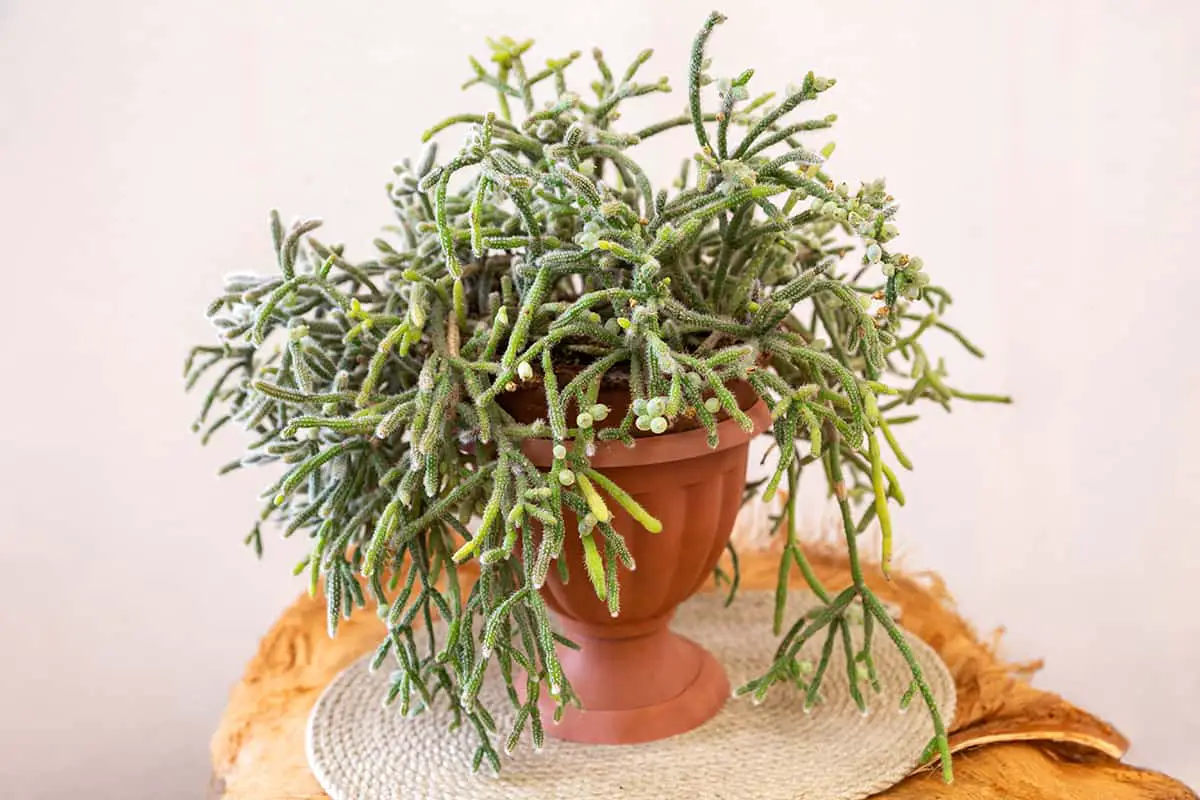
Rhipsalis, a flowering succulent, thrives in both indoor and outdoor settings. You can grow this plant in a pot or hanging basket. It’s recognized by its long, slender stems and small flowers.
Indoors, Rhipsalis needs bright, indirect light. Outdoors, place it in partial shade to protect it from intense sun.
Water your Rhipsalis when the soil is dry to the touch. It prefers well-draining potting mix, to prevent root rot. Keep Rhipsalis in temperatures between 50-75°F (10-24°C). It can tolerate brief drops to about 40°F (4°C).
When you care for Rhipsalis properly, it rewards you with delicate white or pink flowers.
Gymnocalycium (Moon Cactus)
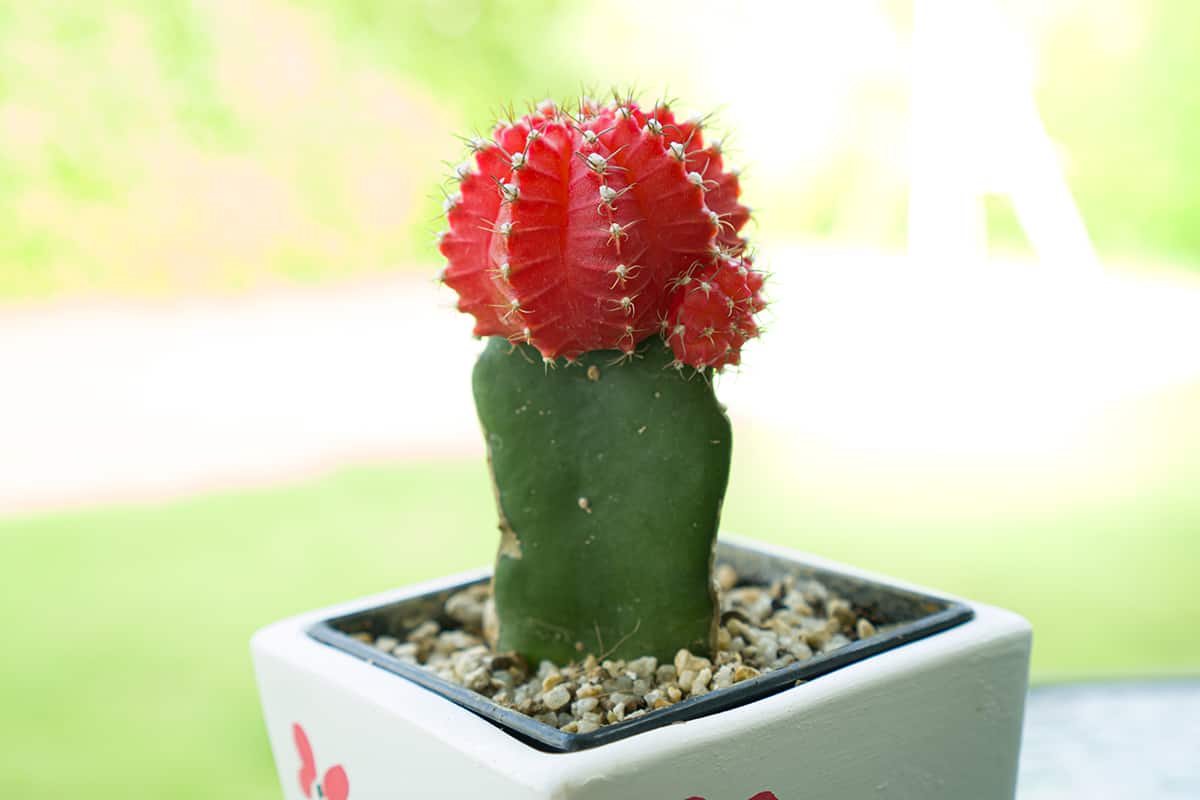
Gymnocalycium, often recognized as the Moon Cactus, is a small and colorful plant ideal for your indoor and outdoor gardens. With its vivid neon colors, it brings a vibrant touch to your space. In the indoor setting, Gymnocalycium thrives with ample light. Make sure to place it in a well-lit area, though direct sunlight can be harmful. The outdoor environment should be warm, as they originate from South America’s temperate zones.
Their watering needs are minimal. Your Moon Cactus requires a well-draining soil to prevent root rot. When the soil feels dry to the touch, offer a moderate amount of water. Gymnocalycium can grow quite well when you meet its basic needs.
These cacti bloom with showy flowers that can attract attention. You might see blossoms in shades of pink, red, or white, depending on the species. The Moon Cactus stays modest in size, which makes it great for small spaces. You can enjoy its growth both indoors and outdoors, without concerns of it taking over.
Anacampseros
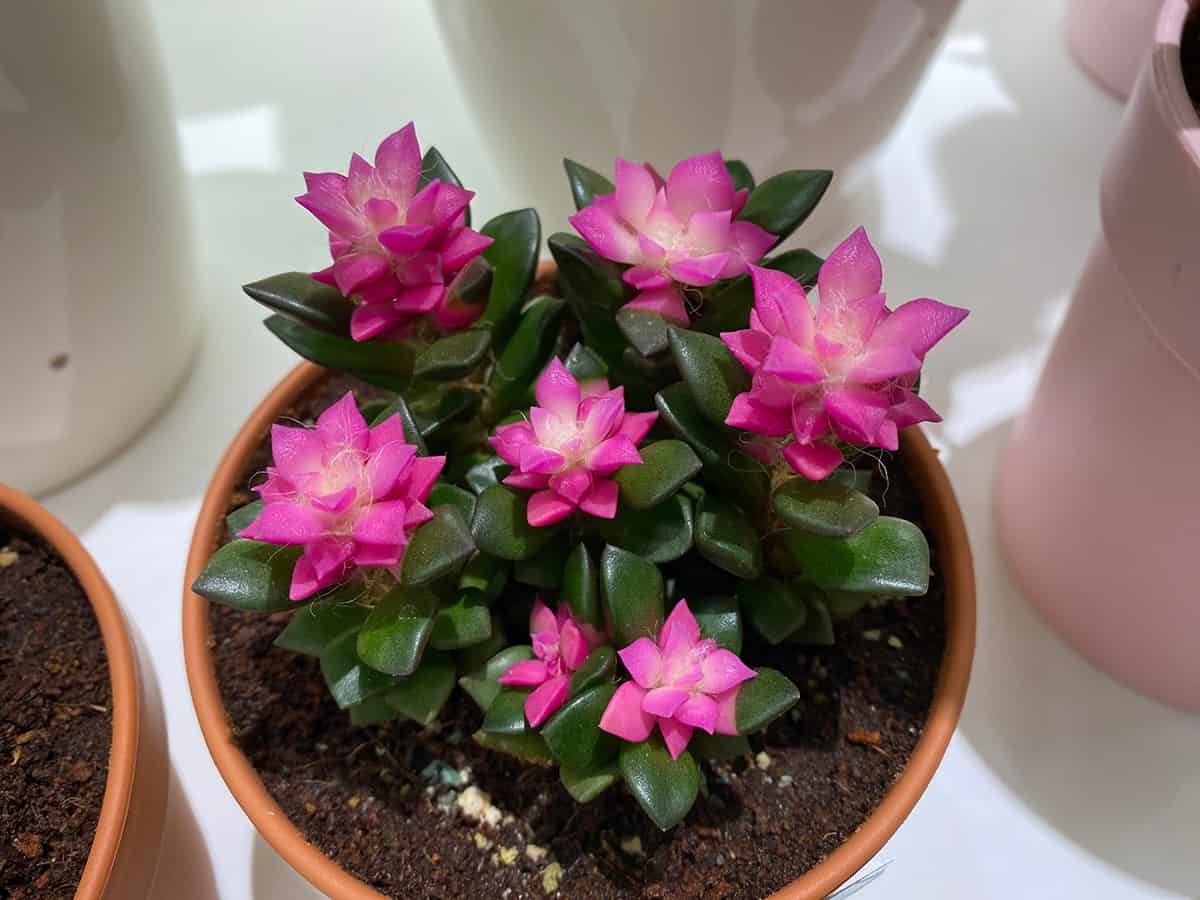
Anacampseros is a succulent that thrives both indoors and outdoors. Its rosette of thick leaves can adapt to various lighting conditions. When kept indoors, a bright spot will help maintain vibrant leaf colors. Some Anacampseros species have leaves that turn pink under the stress of intense light.
For healthy growth, ensure your Anacampseros receives plenty of indirect sunlight. Direct sun can scorch the leaves, while low light may dull the coloration.
Like most succulents, Anacampseros prefers a ‘soak and dry’ method. Wait for the soil to dry completely before watering again. Overwatering may cause root rot. This plant favors average room temperatures, from 65-75 degrees Fahrenheit. Avoid exposing your Anacampseros to freezing temperatures.
Anacampseros blooms with delicate, star-shaped flowers. The blooms often appear in summer, adding charm to your plant collection. Flowering is a sign of a happy, healthy plant.
When caring for Anacampseros, you should repot it every few years. Fresh soil replenishes nutrients and allows space for growth. Choose a well-draining soil mix to prevent water-related issues.
Stapelia
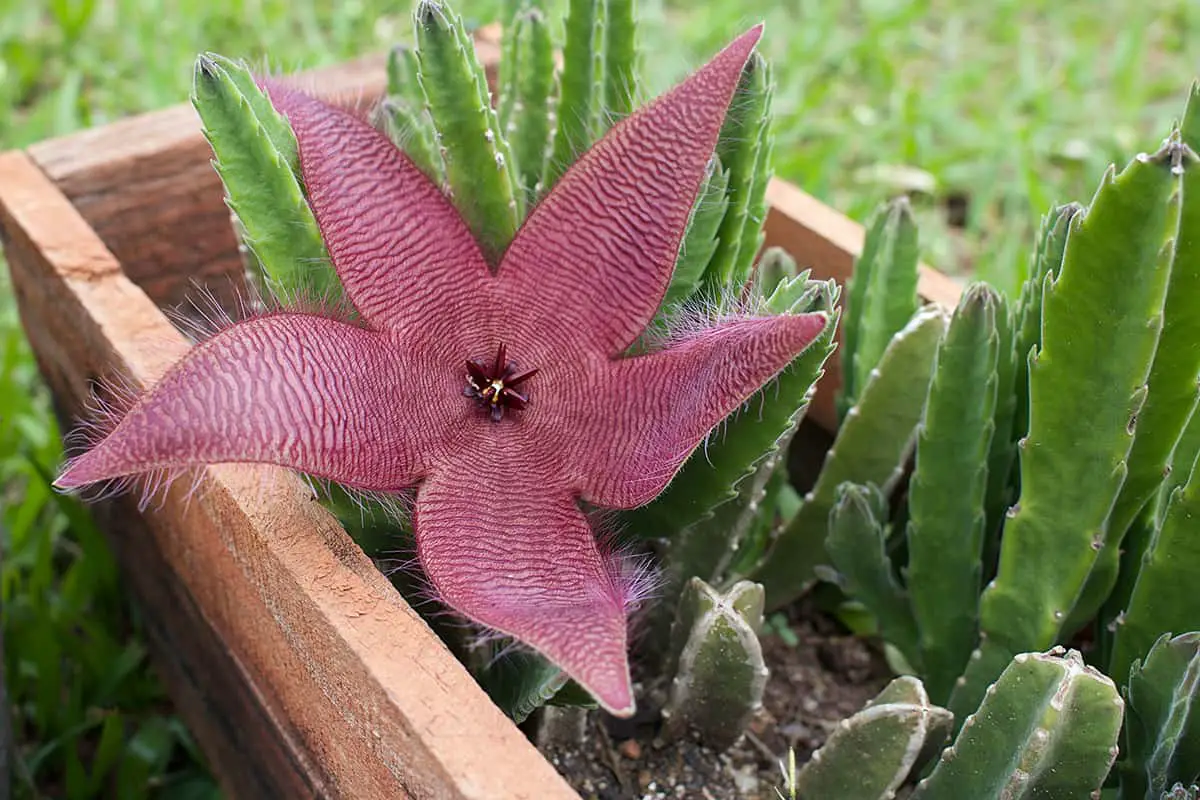
Stapelia plants are unique succulents that boast starfish-shaped flowers, making them a distinctive addition to your plant collection. If you want a succulent with unusual blooms, Stapelia fits your needs.
Your care for these plants should include a well-draining soil mix, akin to what you would use for cacti. Ensure pots have ample drainage. Stapelia plants prefer bright light but not direct, scorching sun. Indoors, a south-facing window is ideal. Outdoor placement should be in partial shade.
You’ll appreciate that they don’t require frequent watering. It is crucial you let the soil dry out between waterings to prevent root rot. Stapelia flowers have a notable trait: they emit an odor resembling rotting meat to attract pollinators like flies.
The growth habit of Stapelia involves fleshy, square stems that can create an intriguing clump. They can expand over time and may need dividing. Protecting Stapelia from cold is essential; bring them indoors during fall and winter in cooler climates.
Crassula (Fairy Crassula)
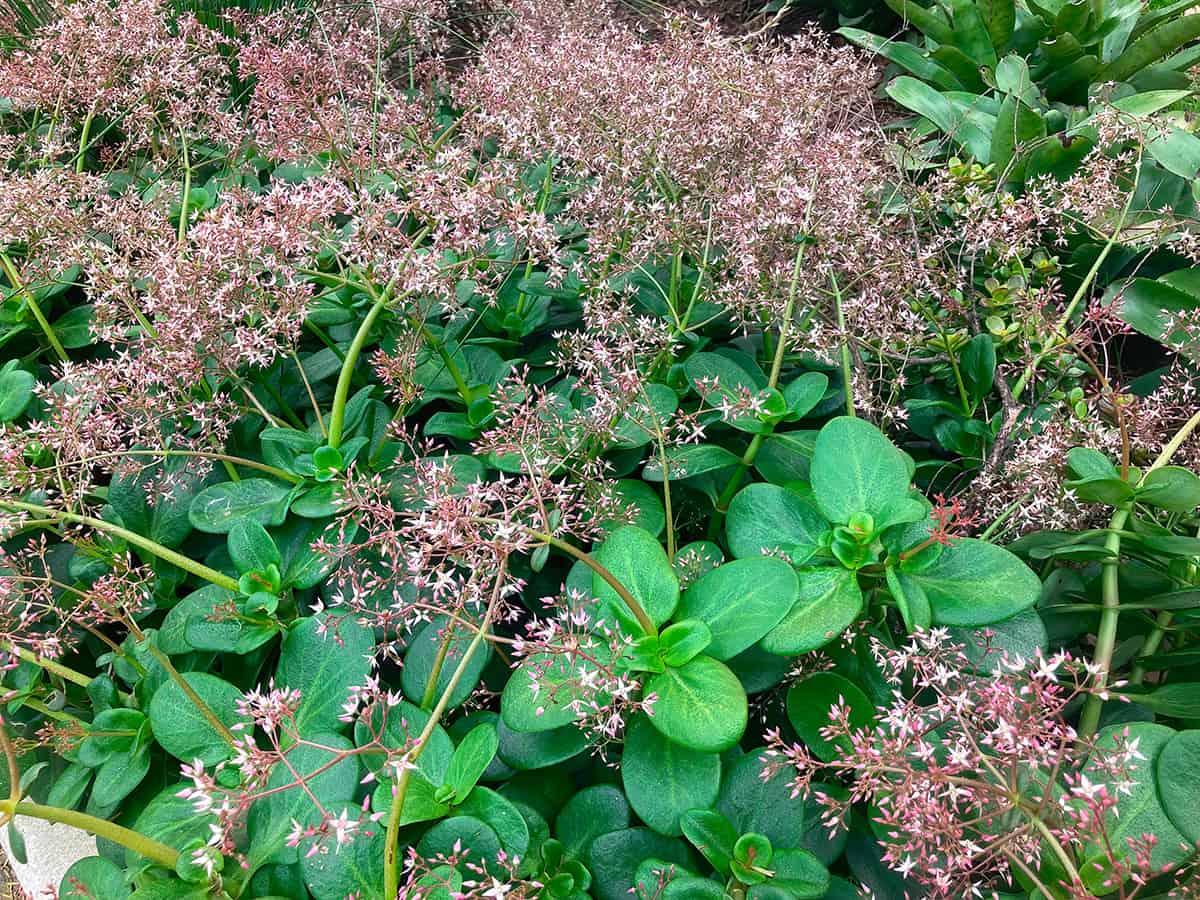
The Fairy Crassula belongs to the robust succulent family. You may know it as the Crassula ovata. As a versatile plant, it thrives indoors and outdoors. These plants are native to South Africa, growing naturally in rocky outcrops.
Your Fairy Crassula requires minimal water. Its thick leaves store moisture, making it drought-tolerant. It’s ideal for busy gardeners. Ensure you place it in well-draining soil to prevent root rot.
In proper conditions, this succulent can flower. You’ll notice small, star-shaped blooms. They add a delicate touch to its sturdy foliage. Light plays a crucial role here; bright, indirect light encourages flowering.
Crassula tolerates a range of environments, from the dry warmth of your living space to a sheltered spot in your garden. Remember to protect it from frost, which can damage its fleshy leaves.
Lithops (Living Stones)
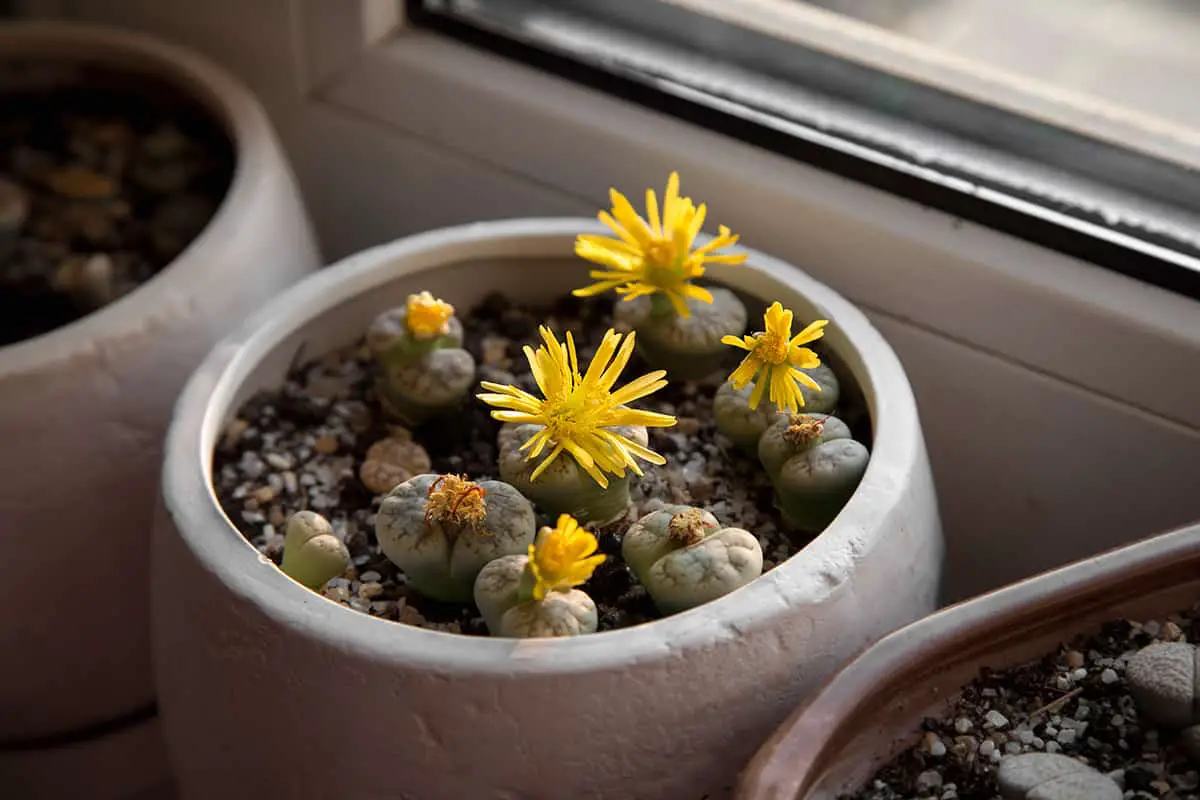
Lithops are intriguing succulents native to Southern Africa. They have evolved to mimic stones in their arid environments. This makes them excellent choices for both indoor and outdoor succulent collections. The fleshy leaves of Lithops store water, allowing these plants to withstand dry conditions.
When caring for your Lithops, ensure they have plenty of sunlight. These plants thrive on bright, indirect light typical to a southern African habitat. Their water requirements are minimal, so it’s essential to allow the soil to dry completely between waterings. Overwatering can lead to rot, a common issue with succulents.
The characteristic fissure at the top of Lithops is where the magic happens. From this slit, dazzling flowers bloom, typically in autumn. The colors can range from white to yellow and even pink. These “flowering stones” create a striking display that contrasts with their pebble-like appearance.
Lithops are adaptable and can grow well indoors provided they get enough light and proper care. They also make fascinating outdoor plants in climates without freezing temperatures. Remember, these living stones prefer a lean soil mix, low in organic material.
Orostachys (Chinese Dunce Cap)
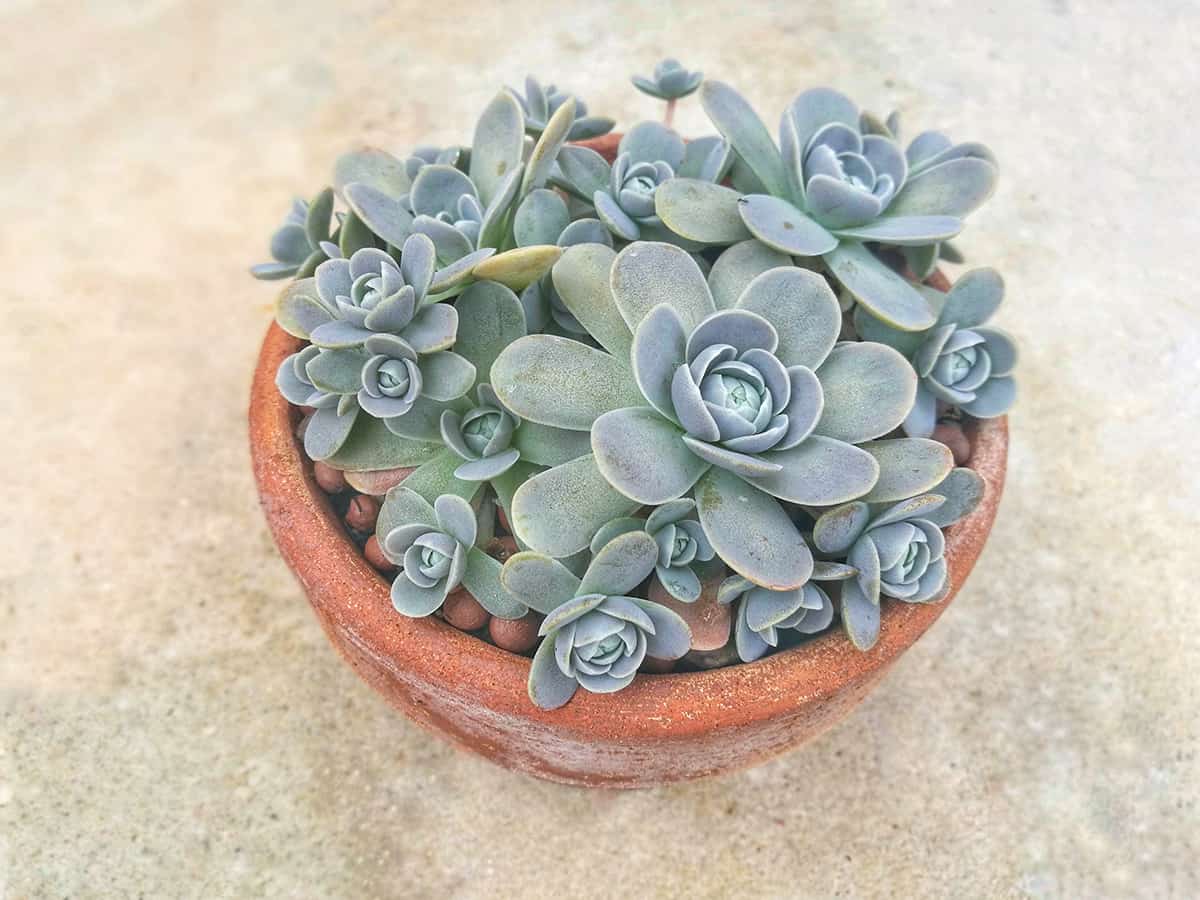
Orostachys, also known as the Chinese Dunce Cap, is a unique and captivating succulent. It’s prized for its distinctive cone-shaped rosettes. These plants are well-suited for both indoor and outdoor growth. They adapt to a variety of settings as long as you provide them with sufficient light.
You can easily incorporate Orostachys in your garden or home. They prefer well-drained soil and do not need frequent watering. These succulents store water in their fleshy leaves, which helps them thrive in dry conditions. You should let the soil dry out between waterings to prevent root rot.
These succulents are hardy to USDA Zone 5. This means you can grow them outdoors in many climates. However, during harsh winters, you may need to bring them inside to protect them from extreme cold. When grown indoors, place them near a window where they can get plenty of sunlight.
While Orostachys is generally easy to maintain, watch out for pests like aphids and mealybugs. These insects can harm your plants if not managed promptly. You should inspect your plants regularly to keep them healthy and vibrant. If you encounter pests, treat them with appropriate measures such as insecticidal soap.
Euphorbia Milii (Crown Of Thorns)
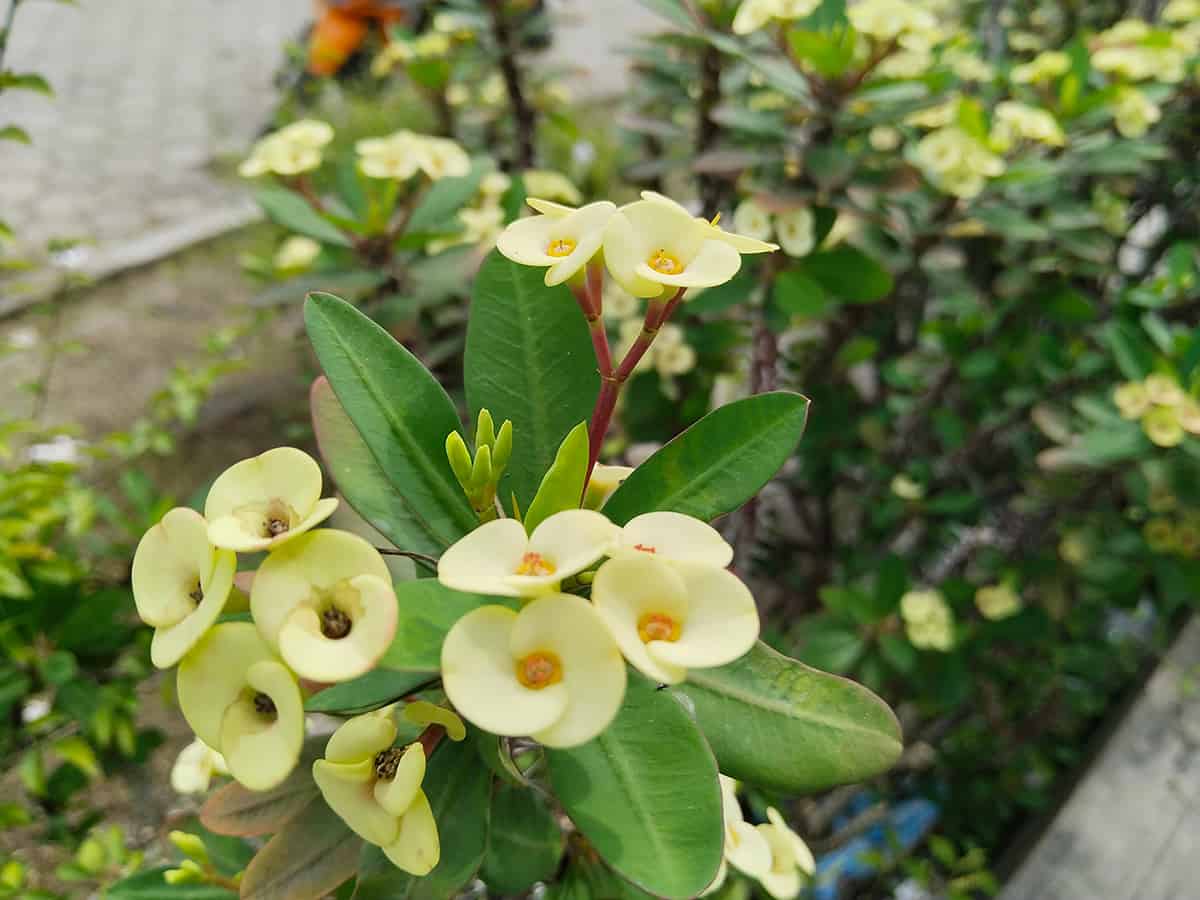
Euphorbia milii, commonly known as the Crown of Thorns, is a versatile plant. Its thick stems are lined with sharp spines, symbolizing the crown of thorns in its name.
This flowering succulent originates from Madagascar. It’s well-suited for your indoor collection or outdoor landscape. With proper care, Euphorbia milii blooms almost year-round. Its flowers are small but surrounded by vibrant bracts in shades of red, pink, or yellow.
For successful growth, position your plant in bright light. It can handle direct sunlight but appreciates afternoon shade in hot climates. Water your Crown of Thorns sparingly; allow the soil to dry completely between watering.
When dealing with Euphorbia milii, use caution. Its milky sap is toxic and can cause skin irritation, so always wear gloves when handling. Despite its toxicity, this succulent remains popular. It’s tolerant of heat and can withstand periods of drought, making it a forgiving choice for gardeners of any experience level.
Huernia
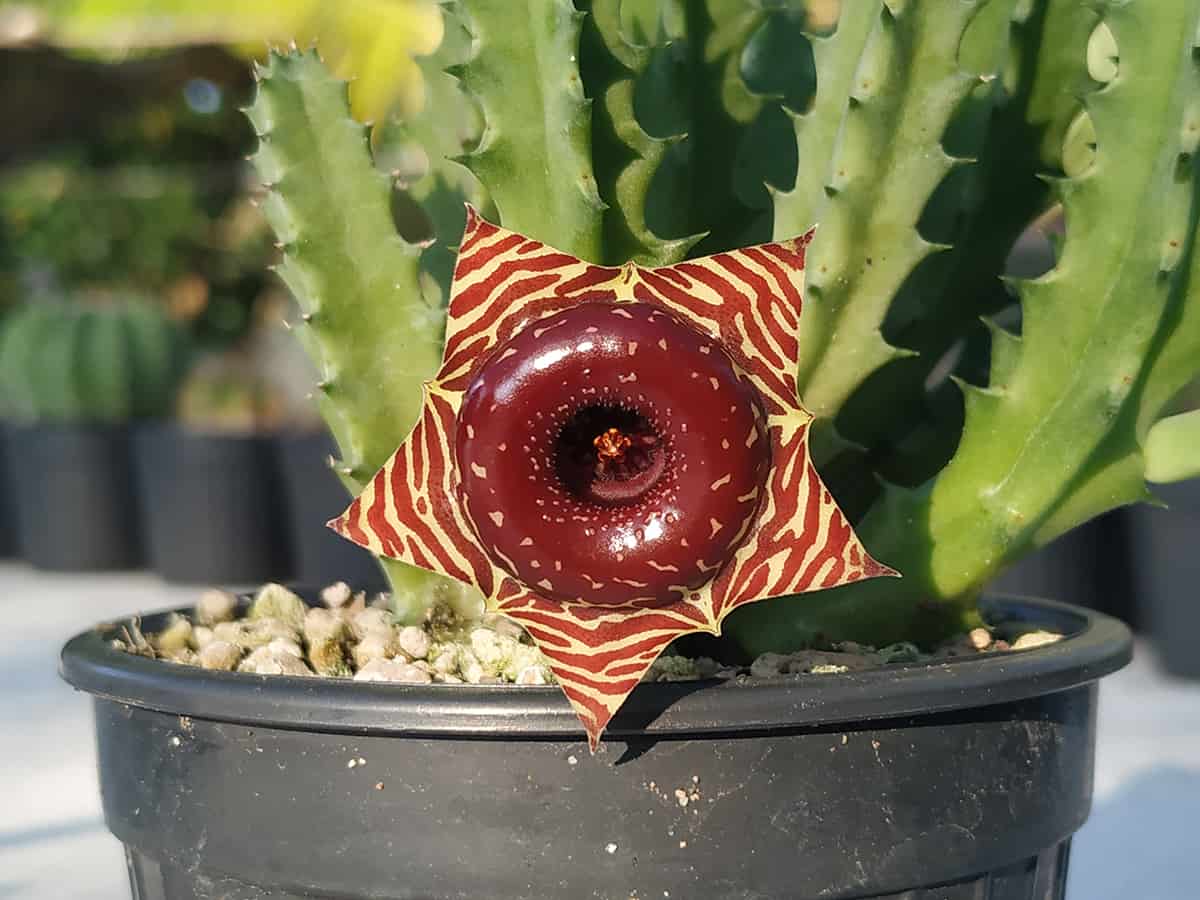
Huernia plants, known for their distinctive star-shaped flowers, thrive both indoors and out. You’ll find them low-maintenance and resilient. When grown indoors, place them in bright, indirect light. For outdoor growth, choose a spot with partial shade to mimic their native habitat.
These succulents demand well-draining soil. Mix in sand or perlite to common potting soil to increase drainage. Water Huernia sparingly; let the soil dry completely between waterings. Overwatering may lead to root rot.
Huernia flowers will delight you with their unique beauty. Flowers may be red, yellow, or even a speckled pattern. They typically appear in warmer months. The blooms offer a surprise, sometimes releasing a scent resembling that of rotten meat intended to attract pollinators in the wild.
Your Huernia will require minimal fertilizing. Feed it once during the growing season with a diluted succulent fertilizer. Prune any dead stems to encourage growth.
